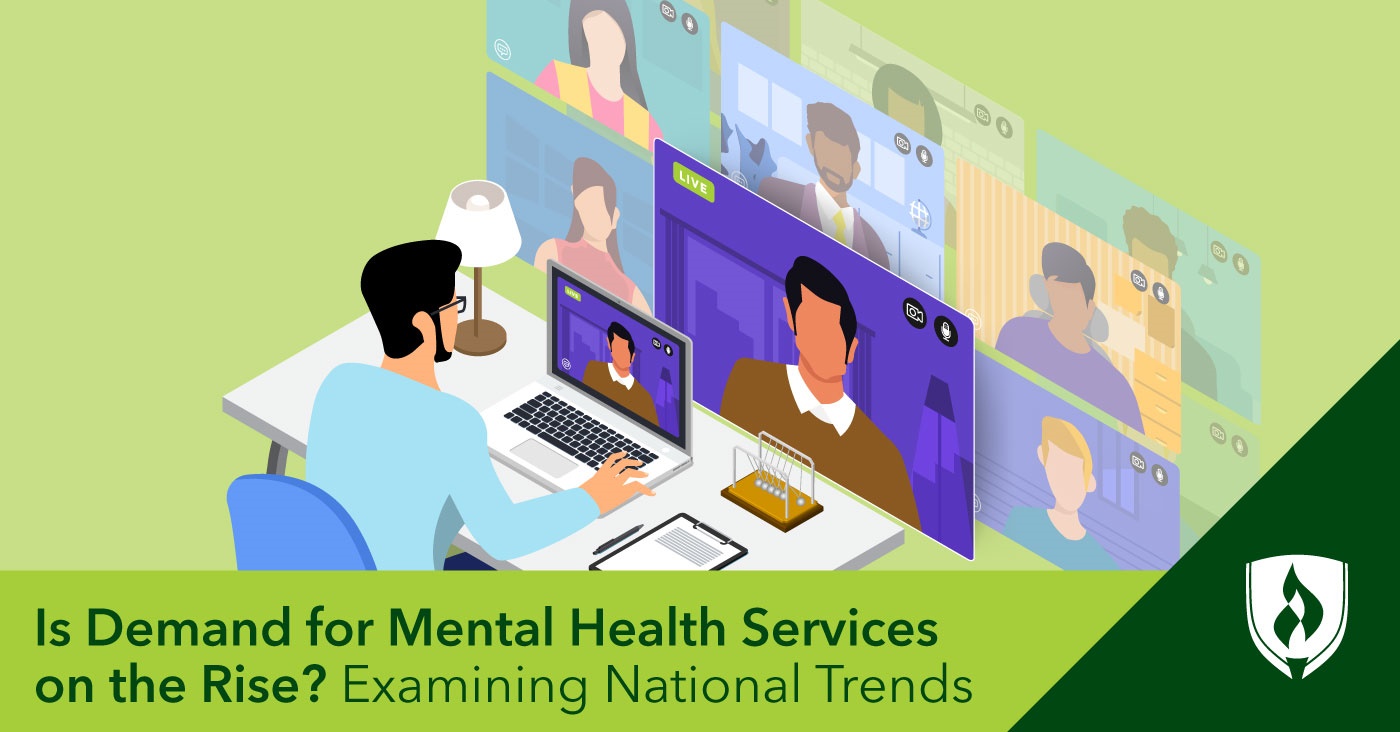Is Demand for Mental Health Services on the Rise? Examining National Trends
By Brianna Flavin on 08/09/2021

There’s nothing quite like a global pandemic to bring your mental health into the spotlight. 2020 was a vicious year for many—the COVID-19 crisis, school closures, political upheaval and more have you wondering if the demand for mental health services is rising.
In June of 2020, the Centers for Disease Control (CDC) reported increases in anxiety and depression at approximately three times the response rate from the final quarter of 2019 (25.5 percent versus 8.1 percent).1 Mental health conditions disproportionately affected “young adults, Hispanic persons, Black persons, essential workers, unpaid caregivers for adults and those receiving treatment for preexisting psychiatric conditions,” according to the CDC.1
Shortly thereafter, the National Council for Mental Wellbeing reported the urgent need for more support in mental health services. Their survey of behavioral health chief executive officers found that 52 percent of behavioral health organizations saw increases in the demand for services.2
Their report also reveals that many organizations also experienced reduced capacity in 2020, lack of solvency or turnover. These factors combined to create a sharp drop in national mental health services that were even available, with 54 percent of organizations closing programs and 65 percent cancelling, rescheduling or turning away patients altogether.2
It’s clear COVID-19 created an amalgamation of challenging circumstances for the mental health field—but how does that shape things going forward? Read on to get a picture of what may come. Explore What Does a Psychiatric-Mental Health Nurse Practitioner Do? to understand more about the vital role they play in addressing mental health challenges.
Is the demand for mental health services on the rise?
This is a complex question to answer. The CDC surveyed mental health from August 2020 through February 2021 and did find rising rates of anxiety, depression and unmet mental health care needs.3 It’s reasonable to think the demand for mental health services would also rise.
But it’s tricky to narrow mental health down to one statistic. With many practices suddenly closing doors or pivoting to telehealth on a dime, it’s hard to measure how many people are seeking help.
Frontiers in Psychiatry released a report in early 2021 studying an adolescent acute inpatient unit in Spain. Researchers found that demand for adolescent psychiatric care actually decreased in the months after the pandemic.4 They suspect this drop to be related to prospective patients’ concerns about exposure to the virus, not because people needed less intervention.
Additionally, the pandemic caused a wave of job losses, pushing the unemployment rate to a peak not seen since the 1930s, according to the Center on Budget and Policy Priorities.5 Their report notes that while unemployment rates were improving as of April 2021, the impacts are far from over, with millions of people experiencing loss of paid work.5
When you factor in fear of exposure to the virus and loss of income or health insurance that may have prevented people from seeking help they needed, you can see how difficult it is to truly quantify the demand for mental health services right now. How do we know how many people want or need mental health services if those people can’t take measurable actions at the moment?
How are people coping? How are mental health providers responding? To find out, we asked licensed mental health providers what they are noticing in mental health demand today.
How has COVID-19 impacted mental health?
“I used to work in the hospital closely with nurses during the pandemic,” says Merissa Goolsarran, mental health therapist at Bright Lotus Counseling. “The pandemic has contributed a great deal of stress and anxiety, especially to those who are working on the frontline.” Goolsarran explains that stress exacerbates new situations like rising debt, occupation changes or deaths in the family. Because of this, she has seen more clients seeking help to cope with stress instead of for traditional diagnoses, like depression or bipolar disorder.
“Many people have turned to substance abuse as a coping mechanism for the stress or struggles they are facing,” says Brian Wind, clinical psychologist and chief clinical officer at addiction treatment center JourneyPure. “As a result, we've seen an increased demand for detox and addiction treatment services.”
“We have seen an increase in contacts for relationship counseling,” says Ginelle Krummey, therapist for Growth Point Collaborative Counseling. Krummey has also noticed increased demand for short-term therapies.
How are mental health providers responding to the pandemic?
“The biggest change to my practice in the past year is that I conduct my services entirely over telehealth,” Krummey says. She explains that the shift really revealed how much self-support and community care therapists need to make their work sustainable. As mental health providers all over moved their work to virtual spaces and struggled with pandemic stressors, many made permanent changes to their practice.
“The pandemic has changed my workflow on a daily basis and has also impacted my personal life,” Wind says. “I’ve spent more time in nature and doing the ‘simple things’ with my son. The pandemic has deepened my sense of gratitude for the simple things in life.”
The adjustments many providers made may also forecast major changes in the industry. “I am proud of making my practice remote,” Goolsarran says. “In doing so, I can service the entire state and reach more clients in a safe, convenient manner.”
What long-term impacts could the pandemic have on mental health?
Teletherapy has already received a boost in widespread adoption because of the pandemic, according to Wind. He believes other aspects of digitization will become an important part of mental health work. “We can look forward to more remote monitoring apps integrating with devices, such as smartwatches that can help mental health professionals deliver comprehensive care.”
“I see a rise in need for solution-focused brief therapy,” Goolsarran says. “Many clients may not fall into traditional diagnoses, but their concerns and needs are still valid.”
“In the next five to ten years, I see big advocacy and emphasis on mental health as an industry,” Krummey says. “The practice of therapy is being disseminated right now through wide-reaching services that underpay therapists and underserve clients.” Krummey says increased attention on mental health will cause more participation—and more resources to allow therapists room to do their jobs well.
Resources and awareness in mental health could also lead to a better array of choices. Goolsarran anticipates more mental health services tailored for specific cultural groups on the horizon. “More diversity is being seen in practitioners entering the field, and this increased cultural knowledge can help reach marginalized groups who put off therapy because of cultural misunderstandings with therapists not of their cultural background.”
Join the mental health movement
One thing is clear: Whether or not the demand for mental health services is rising, this work remains absolutely critical. People seek mental health services for everything from stress to relationships to help with addiction, disorder and more. If you understand the importance of mental health, you know just how big a difference a great mental health provider can make in someone’s life.
Could you see yourself rising to meet the need? Becoming a psychiatric-mental health nurse practitioner (PMHNP) is one excellent avenue to make it happen. Learn more about the process with our article “How to Become a Psychiatric Mental Health Nurse Practitioner: The 6 Steps You Can’t Ignore.”
Related Articles:
1Czeisler, Mark E. et al. “Mental Health, Substance Use, and Suicidal Ideation During the COVID-19 Pandemic — United States, June 24–30, 2020” Morbidity and Mortality Weekly Report. August 14, 2020 [accessed July 2021] https://www.cdc.gov/mmwr/volumes/69/wr/mm6932a1.htm?s_cid=mm6932a1_x#T1_down
2“Demand for Mental Health and Addiction Services Increasing as COVID-19 Pandemic Continues to Threaten Availability of Treatment Options” The National Council for Mental Wellbeing September 9, 2020 [accessed July 2021] https://www.thenationalcouncil.org/press-releases/demand-for-mental-health-and-addiction-services-increasing-as-covid-19-pandemic-continues-to-threaten-availability-of-treatment-options/
3Vahratian, Anjel et al. “Symptoms of Anxiety or Depressive Disorder and Use of Mental Health Care Among Adults During the COVID-19 Pandemic — United States, August 2020–February 2021” Morbidity and Mortality Weekly Report. April 2, 2021 [accessed July 2021] https://www.cdc.gov/mmwr/volumes/70/wr/mm7013e2.htm
4 Díaz de Neira, Mónica et al. “Demand Analysis of a Psychiatric Emergency Room and an Adolescent Acute Inpatient Unit in the Context of the COVID-19 Pandemic in Madrid, Spain” Frontiers in Psychiatry. January 27, 2021 [accessed July 2021] https://www.frontiersin.org/articles/10.3389/fpsyt.2020.557508/full
5“Tracking the COVID-19 Recession’s Effects on Food, Housing, and Employment Hardships” Center on Budget and Policy Priorities. July 6, 2021 [accessed July, 2021] https://www.cbpp.org/research/poverty-and-inequality/tracking-the-covid-19-recessions-effects-on-food-housing-and




